
The Geography Markup Language (GML) is the XML grammar defined by the Open Geospatial Consortium (OGC) to express geographical features. GML serves as a modeling language for geographic systems as well as an open interchange format for geographic transactions on the Internet. Key to GML's utility is its ability to integrate all forms of geographic information, including not only conventional "vector" or discrete objects, but coverages and sensor data.

In computing, JavaScript Object Notation (JSON) ( "Jason") is an open-standard file format that uses human-readable text to transmit data objects consisting of attribute–value pairs and array data types. It is a very common data format, with a diverse range of applications, such as serving as replacement for XML in AJAX systems.
The Theological Markup Language (ThML) is a "royalty-free" XML-based format created in 1998 by the Christian Classics Ethereal Library (CCEL) to create electronic theological texts. Other formats such as STEP and Logos Library System (LLS) were found unacceptable by CCEL as they are proprietary, prompting the creation of the new language. The ThML format borrowed elements from a somewhat similar format, the Text Encoding Initiative (TEI).

C. Michael Sperberg-McQueen is an American markup language specialist. He was co-editor of the Extensible Markup Language (XML) 1.0 spec (1998), and chair of the XML Schema working group.
Data exchange is the process of taking data structured under a source schema and transforming it into data structured under a target schema, so that the target data is an accurate representation of the source data. Data exchange allows data to be shared between different computer programs.
eXtensible HyperText Markup Language (XHTML) is part of the family of XML markup languages. It mirrors or extends versions of the widely used HyperText Markup Language (HTML), the language in which Web pages are formulated.
A structured document is an electronic document where some method such as markup or embedded coding, is used to identify the whole and parts of the document as having various meanings beyond their formatting. For example, a structured document might identify a certain portion as a "chapter title" rather than as "Helvetica bold 24" or "indented Courier". Such portions in general are commonly called "components" or "elements" of a document.
MECS is the Multi-Element Code System, a markup system developed by the Wittgenstein Archives at the University of Bergen. It is very similar to SGML and XML except that it allows elements to overlap.
The Music Encoding Initiative (MEI) is an open-source effort to create a system for representation of musical documents in a machine-readable structure. MEI closely mirrors work done by text scholars in the Text Encoding Initiative (TEI) and while the two encoding initiatives are not formally related, they share many common characteristics and development practices. The term "MEI", like "TEI", describes the governing organization and the markup language. The MEI community solicits input and development directions from specialists in various music research communities, including technologists, librarians, historians, and theorists in a common effort to discuss and define best practices for representing a broad range of musical documents and structures. The results of these discussions are then formalized into the MEI schema, a core set of rules for recording physical and intellectual characteristics of music notation documents. This schema is expressed in an XML Schema Language, with RelaxNG being the preferred format. The MEI schema is developed using the One-Document-Does-it-all (ODD) format, a literate programming XML format developed by the Text Encoding Initiative.
The Office Open XML file formats are a set of file formats that can be used to represent electronic office documents. There are formats for word processing documents, spreadsheets and presentations as well as specific formats for material such as mathematical formulae, graphics, bibliographies etc.
The Publishing Requirements for Industry Standard Metadata (PRISM) specification defines a set of XML metadata vocabularies for syndicating, aggregating, post-processing and multi-purposing content. PRISM provides a framework for the interchange and preservation of content and metadata, a collection of elements to describe that content, and a set of controlled vocabularies listing the values for those elements. PRISM can be XML, RDF/XML, or XMP and incorporates Dublin Core elements. PRISM can be thought of as a set of XML tags used to contain the metadata of articles and even tag article content.
XHTML+RDFa is an extended version of the XHTML markup language for supporting RDF through a collection of attributes and processing rules in the form of well-formed XML documents. XHTML+RDFa is one of the techniques used to develop Semantic Web content by embedding rich semantic markup. Version 1.1 of the language is a superset of XHTML 1.1, integrating the attributes according to RDFa Core 1.1. In other words, it is an RDFa support through XHTML Modularization.
CLIX, a method of using valid XML for overlapping markup.







